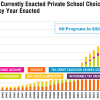President Joe Biden will reportedly use his State of the Union (SOTU) speech to blame corporations for high grocery bills.
The public remains deeply angry at the prices they pay for food shopping. A majority of those voters concerned about inflation cite “the cost of food and groceries” as the source of their angst.
Between January 2010 and January 2021, the price index for food consumed at home increased by less than 18 percent in 11 years. Since Biden became President, it has increased by 21 percent in just three years.
This mainly reflects the impact of high inflation, of course, much of which was baked in due to monetary excess and one‐off supply‐shocks from 2020 through 2022. As supply conditions have improved food prices overall are no longer going up as quickly as inflation in general. But visits to the grocery store are still a reminder of the sharp, enduring food price spikes we experienced in 2022 and early 2023.
This remains a big political problem for Biden in an election year. His administration is thus doubling down on blaming high food prices on greedy companies rather than failures of macroeconomic policy. And why wouldn’t it? The media have spent two years boosting quack corporate greed theories of inflation and downplaying the role of monetary policy. This narrative risks becoming the legacy of this whole episode: much of the public thinks corporate profit‐seeking has been in some way or a great deal responsible for the inflation we’ve experienced, with few attributing blame to the actions of the Federal Reserve.
Of course, this lends itself to a range of terrible policy ideas. Rather than monetary restraint, the supposed answer is price controls and regulations on companies’ pricing structures. It’s reported Biden may even use his SOTU platform to endorse legislation put forward by Sen. Bob Casey (D‑PA), Sen. Elizabeth Warren (D‑MA), and others. All these proposed laws are either economically incoherent or based on highly misleading data.
Shrinkflation
Before the Super Bowl, President Biden complained about shrinkflation—the practice of firms reducing product or portion sizes while keeping package prices the same, thus raising the per unit price of the food, drink, or product.
Have you noticed in the past couple of years how the amount of cereal or chips in a packet have fallen? Biden thinks this is a nefarious plot to rip off customers. Senator Casey has even advocated legislation that would empower the Federal Trade Commission (FTC) to promulgate rules treating this as an “unfair or deceptive act or practice.”
Shrinkflation did happen across a range of food products, particularly in 2022. But this itself is just a manifestation *of* inflation, which ultimately had macroeconomic roots (too much money chasing too few goods).
The Bureau of Labor Statistics, which calculates the Consumer Price Index, already tries to account for inflation that manifests as shrinkflation. Their analysis shows that about 10 percent of the increase in unit prices for snacks occurred through reduced package size, with the same phenomenon, though less significant in scale, for candy and chewing gum, coffee, and ice cream. It may be the case that the basket of goods the CPI examines doesn’t capture every case of inflation, which means it’s plausible that by under‐accounting for shrinking packages, the official CPI still understates the inflation consumers have faced.
The point is that in an inflationary environment, firms must decide whether to raise their headline prices or trim product sizes. Remember, inflation, ultimately, is a rise in all prices across the economy, including firms’ costs. This doesn’t mean all prices will rise by the same amount (supply and demand shifts mean relative prices between goods change too). Nor will inflation affect all prices at the same time—for some firms, costs rose first, and for others their product prices.
But, in time, inflation raises all prices, so just eating losses as your costs go up because of inflation is not an option for companies. As economist Dean Baker told Politico, “Costs have gone up — wages are 20 percent higher than they were in 2019. We’re not going to have a world where people get to keep their 20 percent pay increases and pay what they did four years ago for food.”
The logical implication is that in the absence of shrinking the amount of product within a package, firms would have raised package prices even higher than they did. Banning “shrinkflation” is effectively a mandate to raise package prices, rather than pursuing a size‐price bundle that some (particularly low‐income) consumers might prefer. It would also encourage gaming, with firms no doubt launching new package sizes that they sell concurrently with existing sizes, before discontinuing the latter, leading to costly legal disputes.
Biden attacking shrinkflation is thus all about anti‐corporate vibes—the idea that businesses are screwing you over by squeezing product sizes underhandedly. To the extent he really believes this to be true, however, Biden should probably be grateful to firms that opted to shrink their product sizes. The alternative was higher package prices, which would have made deeply unpopular food price inflation even more salient.
Greedflation
The context for this anti‐business sentiment has been a relentless propagation of “greedflation” theories from Democratic politicians and some economists. These take many forms, but the most popular tale says that firms exploited customers’ knowledge of major business cost shocks from the pandemic and Ukraine war to raise prices by more than was justified by those rising costs. Hence, businesses caused inflation.
The evidence? Greedflation theorists typically use a basic accounting identity to suggest that:
A change in unit prices (inflation) = A change in worker compensation (unit labor cost) + A change in unit profits + A change in unit costs of other inputs.
They then look at various periods and if unit prices have gone up at the same time as unit profits for companies, they conclude that higher prices are being driven by higher profits. The Economic Policy Institute (EPI), for example, produced a report claiming that, between Q2 2020 and Q3 2021, 54 percent of price increases were driven by fatter profit margins. Using the same methodology, Groundwork revived this analysis recently by looking at what happened during Q2 and Q3 of 2023, concluding that “corporate profits drove 53 percent of inflation during the second and third quarters of 2023 and more than one‐third since the start of the pandemic.”
Those periods are cherry‐picked because other periods tell a different story. Chris Conlon, an economist at NYU Stern School of Business, points out that, through the year Q3 2022 to Q3 2023, under this same logic, profit accounted for minus 22 percent of price increases (markups were falling) while labor costs more than accounted for inflation (increasing it 128 percent).
Was the greedflation then because of greedy workers, rather than firms? Neither EPI nor Groundwork have suggested so. Looking at the share of price rises like this is misleading too. Between Q2 and Q3 2023, prices did not increase significantly, so Groundwork was effectively calculating that a tiny change in prices could be accounted for by a similarly tiny rise in profits over that period.
In any case, this sort of analysis by accounting identity is terrible economics. Firms cannot just increase inflation by reaching for profits. If one firm raised prices for customers on that basis, then other competitors would undercut them. Even in markets where firms had more market power, consumers would have less money left over to demand other products, pushing other prices down and having little overall effect on measured inflation.
What about if most or all firms across the economy colluded to restrain output and increase prices at the same time? Then we’d have expected to see real GDP in the economy fall significantly to explain the level of inflation we saw in 2021 through 2023. Yet real GDP grew strongly in the period EPI complained about profits driving inflation and continued growing reasonably last year when Groundwork made the same complaint. So there’s little evidence of these huge effects in the macroeconomic data.
More importantly, the reason consumers have been able to pay these higher prices was because there was a huge increase in the money supply between early 2020 and mid‐2022. If a central bank allows the money supply to get out of control, this can increase total spending power across the economy.
That extra demand for goods and services can produce rising consumer prices and rising profits across many sectors in the short term, not least because wages (a big cost for firms) tend to be stickier. Prices and profits thus rise at the same time, as does real GDP. Yet it was monetary excess causing all this, not greedy companies’ profits causing inflation.
Price Gouging
Unfortunately, many Democrat politicians seem to think it illegitimate for firms (including grocery stores) to raise prices when demand for their product rises (as opposed to their costs going up). That way of thinking also seems to have infected their macroeconomic worldview: if rising prices across the economy at any period can’t be explained by firms’ rising costs, then it must be greed or excessive profit‐seeking, rather than the first‐order effects of too much macroeconomic stimulus.
If all this were just idle musings from populist politicians, that would be one thing. But Senator Warren and others have introduced federal legislation that would make it “unlawful for a person to sell or offer for sale a good or service at a grossly excessive price” during an “exceptional market shock.”
That is, they want to ban companies from “excessive” price increases following “a natural disaster, failure or shortage of electric power or other source of energy, concerted labor action, lockout, civil disorder, war, military action, national or local emergency, public health emergency, or any other cause of an atypical disruption in such market,” regardless of what has happened to demand.
This anti‐price‐gouging legislation would enshrine in law that firms couldn’t raise prices by more than the FTC considered justifiable, with the legislation suggesting this be capped at the level of prices charged pre‐emergency or what the accused business’s competitors are charging. If this legislation had been in place during the pandemic, it would thus have acted as an effective price control across much of the economy suffering from excess demand. That would have been a recipe for prolonged shortages for many goods and services.
The legislation grants an affirmative defense to businesses accused of gouging only if they have revenues less than $100 million and can prove that price hikes arose due to additional business costs. For larger companies with US revenues above $1 billion or who discriminate between buyers from a dominant position, charging more than normal would be a presumed violation with potentially massive fines of “5 percent of the revenues earned by the person’s ultimate parent entity.”
Conclusion
Democratic politicians, including President Biden, are keen to suggest that companies are to blame for the high cost of groceries and shrinking package sizes. Both, however, are symptoms of higher inflation between 2021 and 2023, caused by too much macroeconomic stimulus relative to the economy’s propensity to produce goods and services.
In propagating this false narrative, the federal government isn’t just mis‐educating voters about the ultimate causes of inflation. It is also fueling legislative attempts to control firms’ prices or pricing structures. Giving the FTC powers to judge shrinkflation an “unfair or deceptive act or practice” risks costly legal disputes and companies feeling forced to raise package prices, even when consumers might prefer fewer units of the product within a package. A federal anti‐price‐gouging law risks prolonging shortages of goods in high demand during emergencies.






















